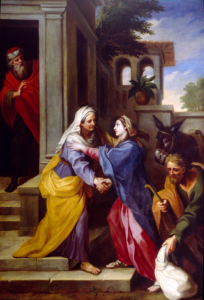The Visitation
Oil on canvas, signed and dated lower left: L. Boulogne le J.f. 1688
Louis de Boullogne, the Younger
French, 1654-1733
Louis de Boullogne, the Younger is a second-generation French painter who with his brother studied at the French Academy and also in Rome. Unlike most other students, however, Boullogne later taught at the Paris Academy and then became its director. He went on to become First Painter to King Louis XIV. His work is known throughout France, especially at Versailles.
When one encounters a work of art, one often has a visceral reaction to some aspect of the work. No doubt the vibrant colors in The Visitation by Louis de Boullogne are a lovely invitation into an appreciation of the painting. In the mid-1800s, Charles George, the Commissaire-Expert of the Louvre, complimented the choice of color and even the “fresh and graceful” brushstrokes. But to really understand a work, one must know the subject matter; after all, the work is but a vehicle for the meaning.
The title refers to the visit of the Virgin Mary to her cousin Elizabeth shortly after Gabriel announced that God had chosen Mary to bear the Messiah (Luke 1). Elizabeth herself had also been the recipient of God’s grace. Mirroring Sarah and Abraham, Elizabeth and Zechariah (also Zacharias) were old and childless. But God sent Gabriel to meet Zechariah with a message of miraculous birth three months before the angel appeared to Mary.
To visit the one who can best sympathize with her situation, Mary travels nearly one hundred miles “in haste,” needing encouragement, for the public ordeal that will doubtless come from her pregnancy. Nazareth was a small town, and “bad” news always travels fast. As Mary greets Elizabeth, now openly six-months pregnant, the baby (John as he will be called) leaps “in her womb for joy.” This first meeting of the cousins—John the Baptist, the Way-Preparer and Christ the Messiah—foreshadows the joy of their partnership in turning the hearts of Israel toward God.
Both mothers have crucial roles to play in the redemption story. Though Elizabeth is the elder and Mary the visitor, Boullogne places the characters on the same step of the house. Their mirrored poses—clasped right hands and left hands placed on one another’s shoulders—show their equality as well. Both mothers are handmaidens of the Lord, being the fulfillment of Isaiah’s prophecies. This certainty of God’s hand upon them gives both women the strength they need to endure the whispers and stares of their community.
Elizabeth’s response to Mary’s unrecorded greeting, wondering that “the mother of my Lord” would come to visit her and blessing Mary and the “fruit of her womb” prompts Mary’s own praise of “God [her] Savior.” Both Mary and Elizabeth know their place in the redemption story—recipients of the Messiah’s saving work.
Possibly influenced by the school of Carlo Maratta, Boullogne chose colors and brushstrokes to make this a winsome and charming portrayal of two godly women. Zechariah as the elder forerunner is thus placed superior to Christ on the steps, yet his son John’s fame and ministry will decrease as the Messiah Himself rises in prominence. Joseph’s presence is not noted in the biblical text, which is an appropriate omission for this first-recorded recognition of the Son of God by those He came to save.
Dr. Karen Rowe Jones, M&G board member
Published 2024


